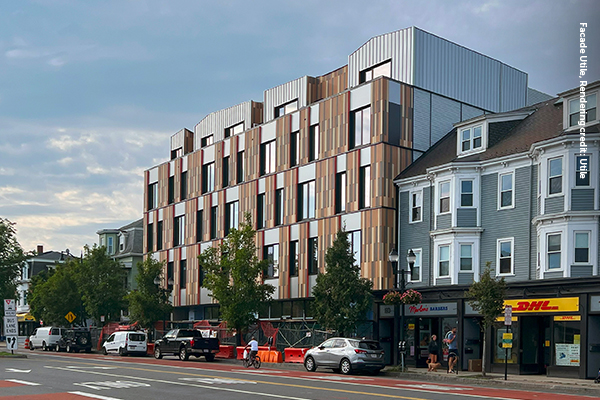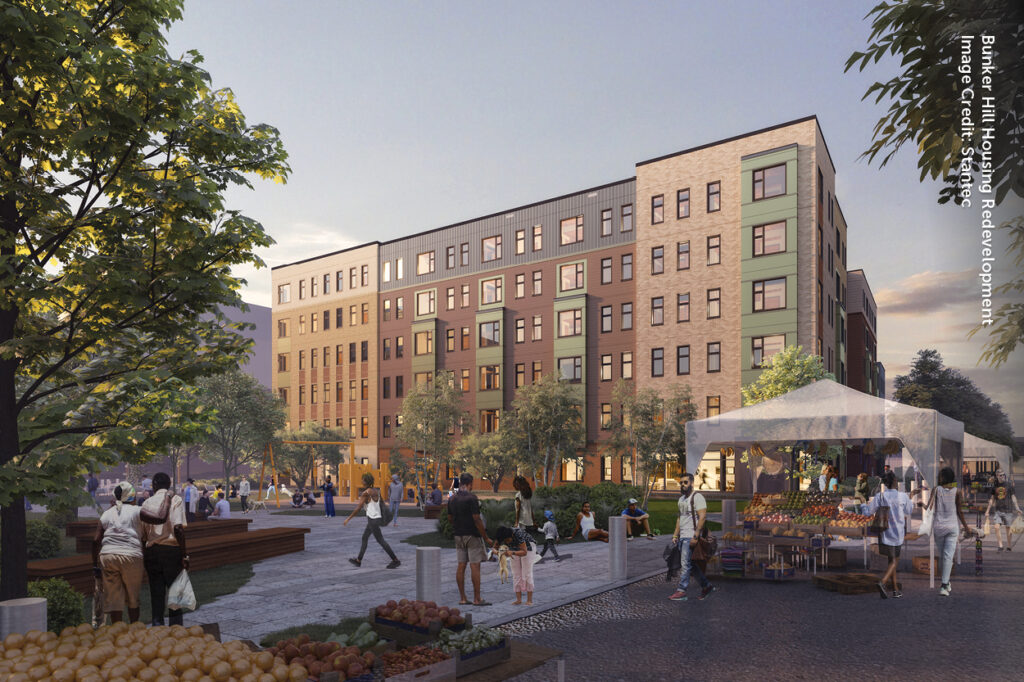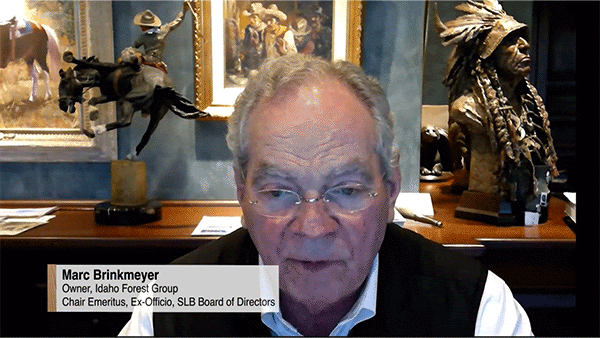HIGHLIGHTS
PROGRAM UPDATES
Think Wood Case Study Highlights Light-Frame’s Flexibility and Value UC San Diego Engineers Create Lasting Memories in Timber Design Course AWC’s State-Level Code Work Protects Lumber Use in Colorado and Georgia WoodWorks Award Program Drives Scale; Winners Announced at AIASPOTLIGHT
The SLB Expands Accelerator InitiativeProgram Updates
Think Wood Case Study Highlights Light-Frame’s Flexibility and Value

A recent Think Wood case study features Africatown Plaza, a seven-story, 126-unit affordable housing project built with light-frame construction. The case study highlights both the value and versatility of light-frame structural systems, noting that the budget-friendly material choice allowed the developer to deploy funds elsewhere, such as with higher-end finishes or to create social spaces that were coveted by the community.
“Generally speaking, wood frame construction is the least expensive,” said Daniel Simons, Principal of David Baker Architects, which designed the building with architect of record GGLO for the Africatown Community Land Trust. “If we can do a five-story wood frame building on grade or over one [story of concrete], it’s the value leader; it usually ends up being what we end up doing.”
Affordable housing was a bright spot for the slow market for apartment starts in 2024. The segment represents a significant opportunity to increase demand for lumber-based products and building systems, with estimates of the housing shortage ranging from 1.5 million units to 7.3 million homes. Think Wood’s storytelling in this segment helps architects and developers learn how wood structural systems can offer cost-effective and timely solutions for affordable housing developers and practitioners, leading to increased specification of wood.
UC San Diego Engineers Create Lasting Memories in Timber Design Course

Architecture students have multiple opportunities to explore wood’s potential through SLB-backed design competitions and studio sponsorships, but reaching engineering programs—with their heavy course load and theory-focused curricula—has proven more challenging. That gap narrowed this spring when the Jacobs School of Engineering at UC San Diego debuted “Advanced Timber Design,” a master’s-level course made possible by SLB funding. The school published a story featuring the course in its online magazine this month.
Over a fast-paced semester, 23 students studied light-frame and mass timber design and competed in a design-build challenge. Working in six teams, they conceived, designed, and fabricated wood structures engineered to support at least 1,000 pounds. Load testing became a spectacle: buckets of sand were added in 50-pound increments while classmates cheered, and awards recognized innovation, efficiency, and engineering excellence. The exercise blended structural analysis with hands-on fabrication, project management, and circular-economy thinking. Following the load test, students deconstructed the spans and upcycled every piece of lumber into bookshelves, standing desks, and other take-home items. “With graduation only three months away, it’s projects like these that not only provide a great opportunity to develop practical skills but also create lasting memories,” said UCSD student Ethan Adamson.
Professor Alessandro Palermo credits the competition format for accelerating learning: “Students learn to appreciate and adapt to field conditions in real time,” he notes, adding that the collaborative setting sharpened soft skills prized by employers. Moreover, seeing modest 1-by-2 strapping and a handful of screws safely span eight feet rewired students’ intuition about wood’s strength and versatility at larger scales. Each of these 23 soon-to-be graduates now enters the workforce with hands-on wood experience—a multiplier that advances the SLB’s mission to embed wood expertise across the design and construction professions.
Building on this momentum, the SLB and UCSD are planning a regional design-build showdown for 2026, inviting peer engineering schools to compete under a common brief. The scalable model promises to turn tomorrow’s engineers into confident champions for wood.
AWC’s State-Level Code Work Protects Lumber Use in Colorado and Georgia
The AWC’s efforts to ensure building codes and standards are friendly to wood occurs not only on the national level, but also on the state level.
In Colorado, the AWC has been actively involved with the Colorado Wildfire Resiliency Code Board as it drafts the Colorado State Wildfire Resiliency Code. The initial draft code was reviewed by the AWC and its Wildland Interface Task Group, which found several potential issues. The draft used the International Code Council’s (ICC) Wildland-Urban Interface Code as a template. However, the draft deviated from the ICC code in terminology and made organizational changes. With the task group’s guidance, the AWC submitted comments on the initial draft that address these issues as well as several other issues important to the U.S. wood product industry, including defensible space, protection of material options, and recognition of performance criteria similar to those in California Building Code Chapter 7A. The AWC will be participating in the next public hearing on June 27.
In Georgia, the AWC engaged on a proposed amendment that could have unnecessarily restricted the allowable number of stories for Type IV mass timber buildings. The AWC successfully defeated the proposal. The proposed amendment, related to specific Institutional Occupancies, attempted to equate the new mass timber construction types—Types IV-A, IV-B, and IV-C—with legacy heavy timber construction, thereby subjecting them to the same height and story limitations. Proponents of the amendment incorrectly claimed that these new mass timber construction types were not recognized by National Fire Protection Association (NFPA) standards, despite their inclusion in both NFPA’s and ICC’s International Building Code model codes. The amendment would have potentially undermined the proven fire-resistance characteristics of the new mass timber construction types. The AWC’s successful opposition preserved the separate and unique code provisions established for mass timber.
The AWC’s field staff and code and standard experts continue to engage and defend access to and fair treatment of wood products in code development and adoption at the state and jurisdiction level.
WoodWorks Award Program Drives Scale; Winners Announced at AIA

When WoodWorks announced the winners of its 2025 Wood in Architecture (WiA) awards at this month’s national AIA Conference on Architecture, attendees were eager to see which teams won for which projects. But the awards are much more than beautiful wood buildings (though they are that too).
The award program is part of a strategy to drive scale, contributing to a circle of influence where WoodWorks supports individuals new to wood who become experts that go on to inspire and influence others through exemplary wood projects. WoodWorks promotes the winners widely. The awards also help ensure continued expansion of the WoodWorks Innovation Network (WIN) with quality projects and support the WoodWorks goal of being nimble, aware of both design trends and potential issues. The relationships established with nominated teams are also invaluable, resulting in everything from project leads—many experienced architecture, engineering, and construction professionals have suggested that peers new to wood should contact WoodWorks—to opportunities for tours, where winning teams directly educate others with less experience.
The nine winning projects showcase wood in a range of building types and regions across the United States, from a multifamily Passive House development with a mass timber/light-frame hybrid system in Massachusetts to a specialized learning environment at Washington’s only American Sign Language–English bilingual school.
“Each project tells a story about innovation and a shared commitment to excellence,” said WoodWorks CEO Jennifer Cover in a press release. “Whether for work, research, learning, or home, these buildings showcase wood as a resilient and flexible material in applications that designers can repeat and build upon.”
Spotlight
The SLB Expands Accelerator Initiative

In 2025, the SLB is expanding its accelerator program initiative to drive innovation in wood construction with a focus on affordability and housing access. Building on the success of programs in Boston, Georgia, and New York City—launched in partnership with the USDA Forest Service—the SLB is now exploring collaborations with cities in Colorado, Pennsylvania, Oregon, California, and in Washington, D.C.
In New York, two projects from the NYC Economic Development Corporation’s 2024 Mass Timber Studio have moved toward construction: the Walter Gladwin Recreation Center and a Brooklyn Public Library branch, both expected to break ground this year. A second round of applications for the program closed in April, and the SLB and program partners have reviewed and selected finalists. One of the finalists has been selected to construct 500 new mixed-income housing units on Staten Island, becoming one of the largest mass timber residential development projects with affordable housing in the entire country.
Georgia’s Mass Timber Accelerator, managed by the Georgia Forestry Foundation, is providing direct funding and technical support to three active projects. The accelerator launched a new call for applications and is expanding into key urban centers through its Mass Timber Hubs initiative. These educational hubs in cities throughout Georgia, developed in partnership with WoodWorks, aim to engage local design and construction professionals to share success stories, discuss lessons learned, and grow momentum ahead of the June 30 application deadline.
Our latest SLB Insights article takes a deeper look at the impact of the accelerator initiative and the SLB’s work to expand that impact and support the growth of wood construction nationwide.
Industry Resources
FEA's Housing Dashboard
FEA’s Housing Dashboard
These housing dashboards are provided compliments of Forest Economic Advisors (FEA).
View the May Housing Dashboard
View the June Housing Dashboard
Virginia Tech's Monthly Housing Report
This monthly housing commentary report is a free service of Virginia Tech and is intended to help one gauge future business activity in the U.S. housing market.
April 2025 Reports (released in June 2025)
Part A: April Housing Commentary
Part B: April Economic Conditions



